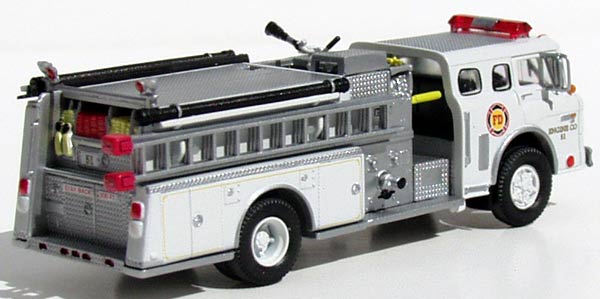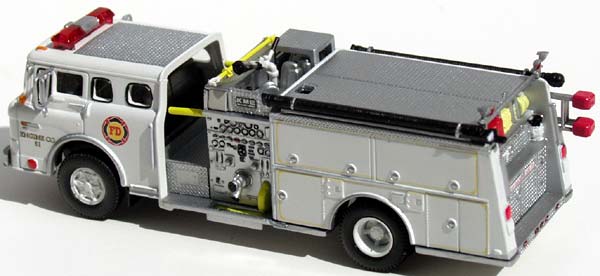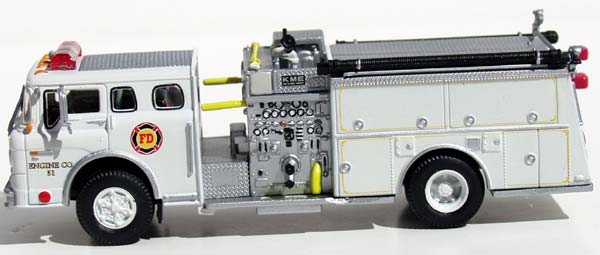Please note: The opinions expressed in our reviews are the views of the reviewer and do not necessarily reflect the views and opinions of the 1/87 Vehicle Club.
model critique by Jeff Webster

When Bob Johnson asked me to write a review, I jokingly
said I'd have to expand it from "Awesome!" That is the first
impression of this model. Since Athearn released their Ford C truck
model, fire modelers have been hoping for a fire truck model on the
chassis. Then Athearn goes and blows us all away with this piece with
a dedicated canopy cab and rescue pumper body. This model will be popular
across the board with fire collectors, train modelers, and vehicle
collectors. While the prototype on which this truck was based appears
to be a late '80s model, the truck will fit in nearly a 40-year span
from the mid-60s to today as many of these are still in front line
service. In addition, the model will fit in well on any layout from
inner city to rural scenes. This model was often referred to as a "belly
button" fire truck as everyone had one. The Ford C saw service
in most major cities' fire departments including Boston, Chicago, and
Los Angeles. The FDNY is probably the only major city to not have used
the chassis in some form. However, the NYPD did have several heavy
rescue/emergency services units (ESU) style trucks. |

The model itself is really great and is the best 1/87 scale fire truck
released to date by any manufacturer. The quality and attention to
detail rivals the best resin cast models. I would also put it in the
running for the best 1/87 model truck to date as well; it is simply
that good! Every place you look on this model there just seems to be
one more detail added that could have been overlooked without detracting
from the model. However, Athearn added them and it really elevates
the model to a new level. Overall, the model is completely new and
different from the original Ford C truck releases with only some trim
parts and wheel sets carried over (on some models; others get completely
new wheels!). Even the bumper is new. Starting with the cab, Athearn
created an all-new "Canopy" cab with rear-facing crew seats.
Some of the details added are forward flashers on the front that are
transparent red lenses, great diamond plate on the cab roof over the
doghouse, and side marker lights on the doors. There are two axes on
the rear bulkhead. The mansaver bars at the rear cab entrance are in
scale too. The light bar is a very nice version of a modern bar and
will find its way onto other fire truck models, I'm sure. They even
added both grab rails for the cab entrance and at the base for tilting
the cab. |

As good as the cab is, the body is really great! There are so many
fine details that capture the eye. Doing a walk around, starting with
the pump panel: it has gauges that are actually recesses and trimmed
in black. There is also an addition of hose discharges. Both of these
features really make it look like a real engine and could have been
simplified with just circles for the gauges and an end cap instead
of the discharge. The body on the engineer's side has high-side rescue-style
compartments with the now popular ribbed hard suction. This suction
hose is well done and is in scale. Often times this hose on fire engines
looks either too large or too small. At the rear, once again there
are many details. First off are the hoses in the bed of varying sizes
and colors. One can see that the prototype was a city rig as there
isn't much large diameter hose. There are also sign plates for the
engine number and the Keep Back warning as well as a place for a license
plate. It is very nice of them to leave this blank for customization.
The subway rail with marker lights is very well done. A few compartments
and marker lights round it off. On the officer's side we get another
section of hard suction but this one has a strainer on the end which
is an up to now overlooked feature. There is a 3-section ladder with
the head protectors on the rails. Again, the panel has an added intake
connection instead of a simple end cap. Athearn could have simply left
off these details with no complaints but went the extra mile for realism.
Looking at the model from the top shows a lot of tread plate; this
tread plate is very well done. Athearn could make a ton of money off
modelers by just selling sheets of this stuff! The deck gun is very
nicely done and has details beyond just a bent piece of plastic. In
addition, there are details within the gun recess. The kicker is the
dry wall hook on the bulkhead! Again it could have been omitted but
wasn't. The graphics are the very best. My sample even had gold pinstriping
that is the thinnest I have ever seen. The variety of colors of the
initial releases should suit most.
Listening to other fire collectors (folks who haven't held the
actual model yet), negative comments have been few and very far in
between. Those made were not even necessarily negative but things they
would rather have been done to the model. One was that it appears to
be a too modern version of the Ford C. The model can easily be backdated
by dropping the fire body onto one of the standard Athearn Ford C truck
chassis. But since the crew cab has been around since the mid '60's,
a simple light change could be the answer. If one would like a standard
body rather than a rescue style I'm sure an IHC Mack body could easily
be added. From a modeling standpoint, I didn't want to tear apart the
sample just to satisfy my quest to see how easily it can be modified.
But it does look like it can be disassembled fairly easily. The only
suggestion I have and it may come on the regular releases, is painting
the ends of the hard suction silver. They added silver rings on the
hose but the ends were left black. There have also been some comments
on the price. However, there is absolutely no comparison in quality
to other manufacturers' 1/87 scale fire trucks on the market today.
Plus, this is comparable in price to other trucks from the European
companies. A quality resin model costs a great deal more and must come
from overseas.
Jeff Webster |
|